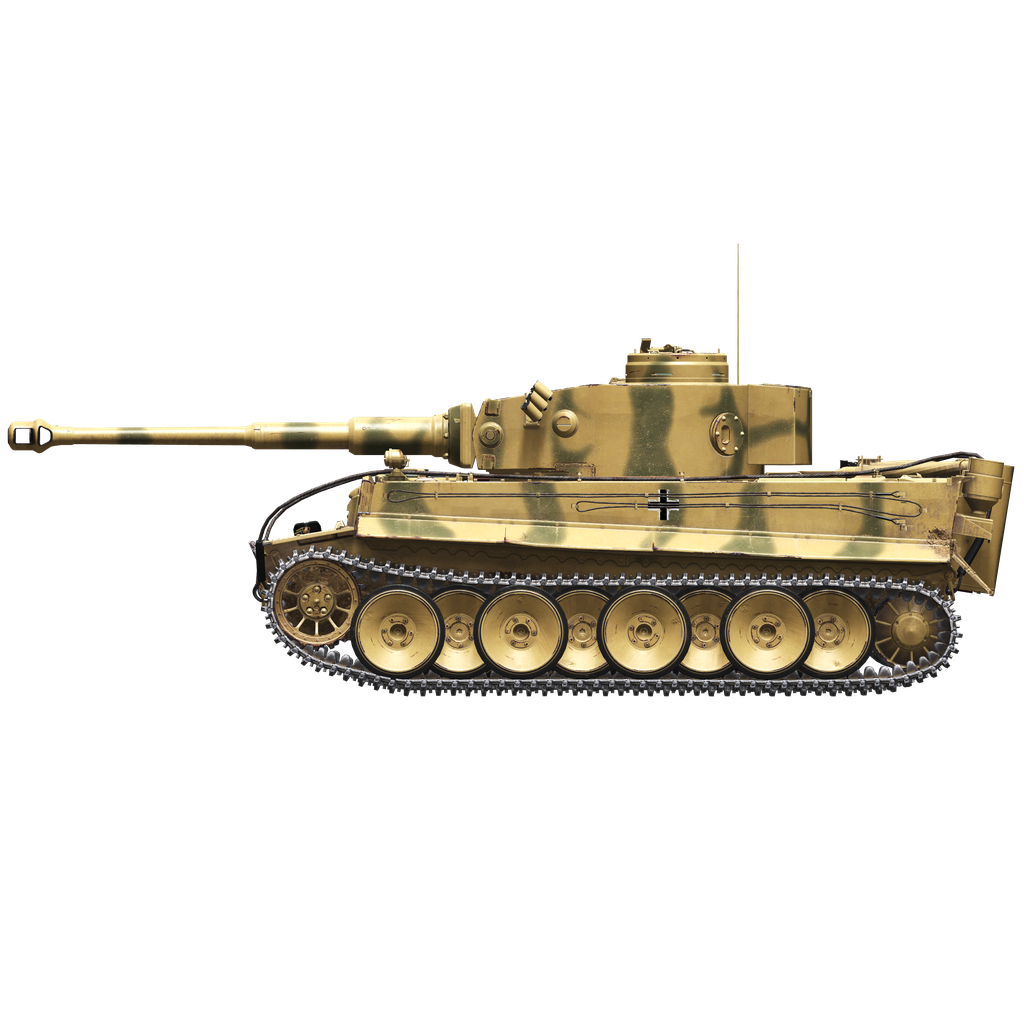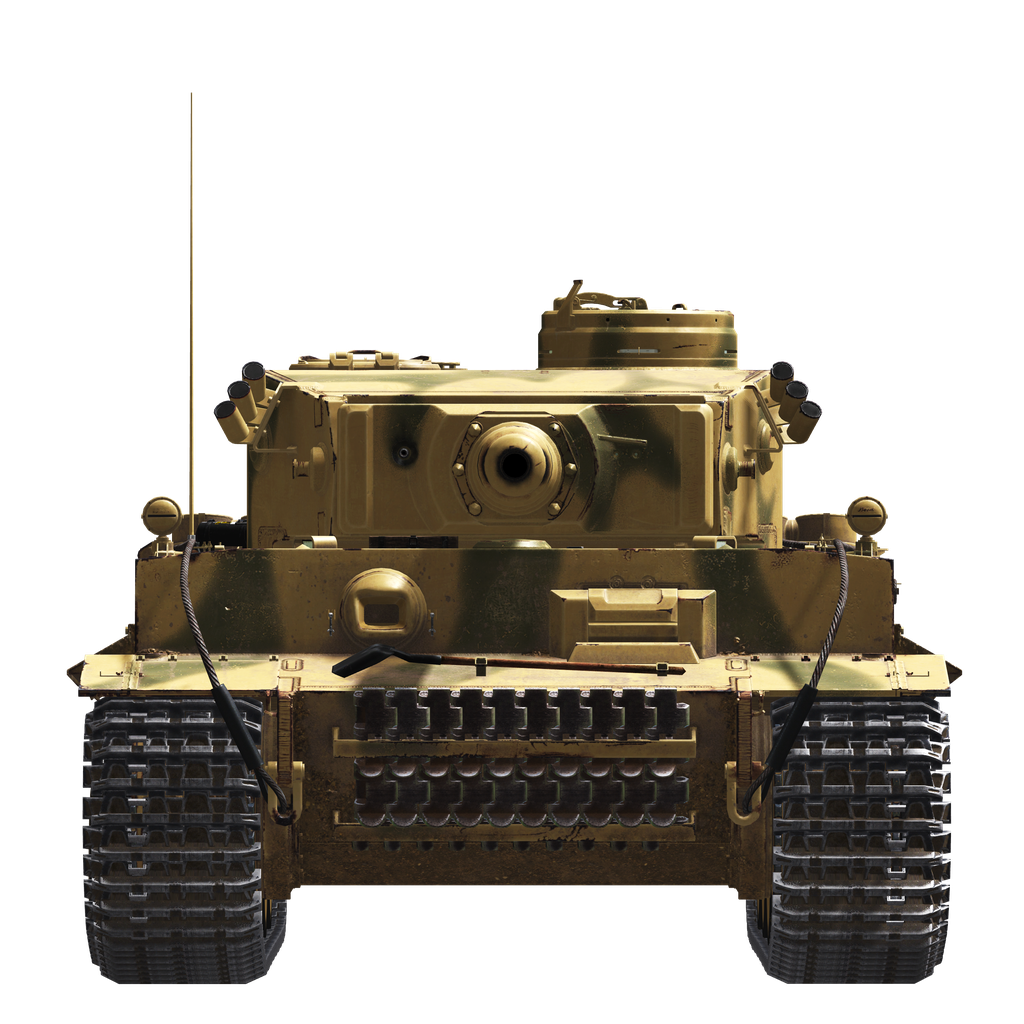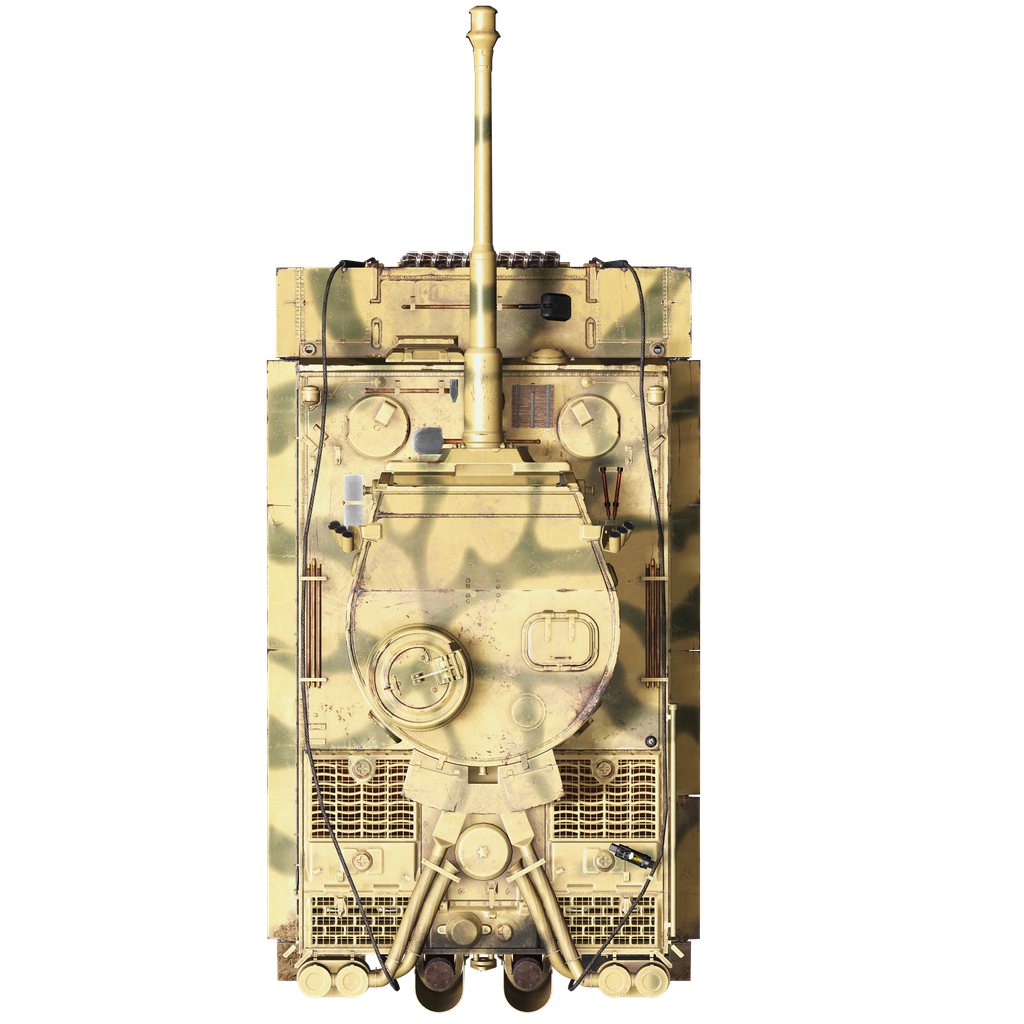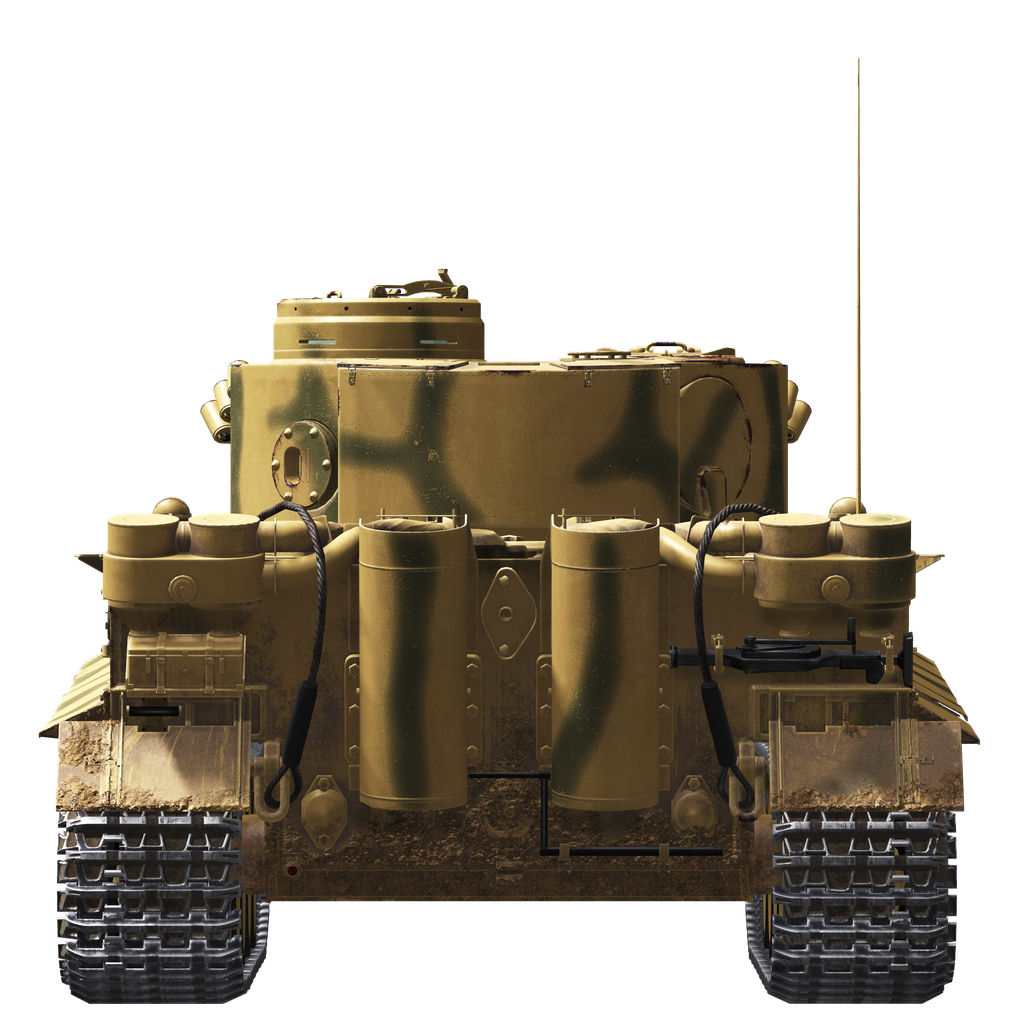Work on a heavy breakthrough tank began in Germany in 1937. The work was carried out by Henschel, headed by Erwin Aders, but all these projects were actually medium tanks in terms of combat weight, armament, and armor. It was only the experience of fighting on the Eastern Front that changed the requirements for a heavy tank. Of the two prototypes created according to the new requirements, the Henschel tank was chosen for mass production. The vehicle received the designation Pz.Kpfw.V Ausf.E and in the continuous indexing system of Wehrmacht vehicles — Sd.Kfz. 181. During production this designation was changed to Pz.Kpfw.VI Ausf.H1, although the tank did not undergo any serial modifications. The Tiger was the first German production tank to be fitted with the new staggered roller chassis.
The Pz.Kpfw.VI Ausf.H1 (Sd.Kfz. 181) had a classic design with a frontal-mounted transmission. The hull of the tank was welded from armor plates, joined with a tenon and welded with a double seam. The interior of the hull was divided into four compartments: transmission, control, fighting, and engine.
The mechanical transmission units were located in the transmission compartment located at the front of the tank, and partially in the control compartment.
The control compartment housed the driver's and radio operator's seats, steering wheel, control levers, transmission units, control instruments, radio station, flexible machine gun and its ammunition.
The fighting compartment was located in the middle part of the tank. Above it was a welded turret with a cannon and a coaxial machine gun, a sight, and observation devices. It also housed the seats of the tank commander, gunner and loader. The ammunition was placed along the walls of the fighting compartment, next to the driver and under the rotating turret floor. The turret was rotated by a hydraulic drive.
The engine compartment was located in the rear of the tank, separated from the combat compartment by an armored partition. It contained a Maybach HL 210 P30 carbureted gasoline engine.
The armament included an 88 mm KwK 36 cannon with a barrel length of 56 calibers, two rifle-caliber machine guns, and smoke grenade launchers. Types of gun shells: 8.8 cm Pzgr. 39 armor-piercing (weight 10.16 kg, initial speed 800 m/s, armor penetration 129 mm at a distance of 500 m), 8.8 cm Pzgr. 40 sub-caliber (7.3 kg, 930 m/s, armor penetration 201 mm at minimum distance), cumulative 8.8 cm Gr. 39 HL (7.65 kg, 600 m/s, armor penetration 90 mm) and fragmentation 8.8 cm Sprgr L/4.5 (9.0 kg, 820 m/s).
The chassis of the tank had large-diameter rollers arranged in a checkerboard pattern: a large number of these, especially since half of them were double, combined with double individual suspension provided a smooth ride and acceptable maneuverability, but such a chassis proved to be very labor-intensive to operate.
A total of 1,364 Tigers were produced. The Pz.VI entered service with heavy tank battalions. In August 1942 these tanks participated for the first time in combat on the Leningrad Front, during which time 5 out of 7 vehicles were lost. Two months later the Tigers of the 501st Battalion were deployed to North Africa. 144 Pz.VI tanks took part in Operation Citadel in the summer of 1943, 73 of which were destroyed by Soviet troops in July and August.
In 1942-1943, the tank was the strongest in the world in terms of its overall combat qualities. The vehicle's advantages included powerful weapons (which by 1944 could hit all enemy self-propelled guns and tanks head-on at long distances) and armor, well-designed ergonomics, and high-quality surveillance and communications equipment. These tanks were actively used on all fronts until the end of the war.
The only country other than Germany to receive Tigers was Hungary — in 1944 it received 3 vehicles.
Used sources:
1. M. Baryatinsky “Heavy tank “Tiger””, magazine “Armor Collection” No. 6 (21) 1998
2. A. Lobanov “Hitler’s Tank Forces” 2010
3. M. Hayton “Tiger Tank. Panzerkampfwagen VI Tiger 1 Ausf.E (Sdkfz 181)" 2011
Developed by Henschel company in 1942, first combat action took place on Leningrad front in August 1942.
The tank was famous for its powerful armour and 'square' look. Its wheels are placed in a checkered pattern to optimize ground pressure and provide additional protection for the hull sides, but this made the chassis repair complicated and often lead to a loss of a damaged tank.
The tank could be equipped with six mortars mounted on the turret and designed to shoot smoke grenades at a distance of about 80 meters.
The main trump card of this machine was its powerful 88-mm long barelled gun KwK 36 developed on the base of the anti-air gun Flak 18/36. This weapon allowed Tigers to destroy enemy tanks at large distances - their firepower was unmatched on the battlefield until IS-2 heavy tanks appeared.
Because of its advanced and complex design, Tigers were very expensive to produce (800 000 Reichsmarks, about two times more of the most other tanks of that time).
Total 1354 Tiger tanks were produced since August 1942 till August 1944.
Unladen weight: 57000 kg.
Length: 8.5 m.
Width: 3.7 m.
Height: 2.9 m.
Clearance: 470 mm.
Engine Maybach HL 210 P30 (petrol).
Maximum power: 650 HP at 3000 RPM.
Maximum RPM: 3000 RPM.
8 speeds gearbox.
Maximum road speed:
1-st: 2.8 kph.
2-st: 4.2 kph.
3-st: 6.1 kph.
4-st: 9.1 kph.
5-st: 14.0 kph.
6-st: 20.8 kph.
7-st: 30.1 kph.
8-st: 45.0 kph.
Reverse 1-st: 3.7 kph.
Reverse 2-st: 5.5 kph.
Reverse 3-st: 8.1 kph.
Reverse 4-st: 12.0 kph.
Maximum offroad speed: 25 kph.
Fluids:
Internal fuel tanks capacity: 530 l.
Engine oil system capacity: 30 l.
Summer engine coolant: 120 l. of 40% glysantin
Winter engine coolant: 120 l. of 60% glysantin
Endurance range: 140 km.
Maximum oil consumption: 4 l/h.
Hull armour:
Upper front: 102 mm rolled armour.
Middle front: 102 mm rolled armour.
Lower front: 102 mm rolled armour.
Bottom front: 63 mm rolled armour.
Upper sides: 82 mm rolled armour.
Lower sides: 63 mm rolled armour.
Upper rear: 82 mm rolled armour.
Lower rear: 63 mm rolled armour.
Roof: 26 mm rolled armour.
Roof grates: 25 mm cast armour.
Bottom: 26 mm rolled armour.
Bottom above tracks: 26 mm rolled armour.
Turret armour:
Upper front: 102 mm rolled armour.
Lower front: 90 mm rolled armour.
Sides: 82 mm rolled armour.
Rear: 82 mm rolled armour.
Roof: 26 mm rolled armour.
Cupola: 75 mm cast armour.
Gun mantlet: 100 mm cast armour.
Main gun: rifled, 8,8 cm KwK 36 L/56.
Barrel length: 53.3.
Elevation: +11°..-4°.
Ammo: up to 92 rounds.
Usable rate of fire: 7 rounds per minute.
Turret drive: hydraulic, 60 seconds per rotation.
Gun ammunition:
8,8 cm Pzgr. 39 armour piercing high explosive (APHE): 10.16 kg, 800 m/s, 129 mm at 500 m.
8,8 cm Pzgr. 40 armour piercing composite rigid (APCR): 7.3 kg, 930 m/s, 201 mm point blank.
8,8 cm Gr. 39 HL high explosive anti-tank (HEAT): 7.65 kg, 600 m/s, 90 mm.
8,8 cm Sprgr L/4,5 high explosive (HE): 9.0 kg, 820 m/s, 900 g explosives.
Machineguns: 7.92 mm Maschinengewehr MG 34.
Bullet mass: 11.5 g.
Muzzle velocity: 855 m/s.
Armour penetration at 100 m: 11 mm.
Rate of fire: 900 rounds per minute.
Coaxial: 21 belts, 150 rounds per belt (3150 rounds).
Bow: +-15°/+20°..-10°, 15 belts, 150 rounds per belt (2250 rounds).
Gunsights:
Tzf 9b gunner binocular scope-sight, field of view 26°.
KZF 2 machinegunner scope-sight, field of view 18°.
Radio equipment:
VHF Fu 5 transceiver with additional Fu 2 receiver.
4 intercom terminals.





